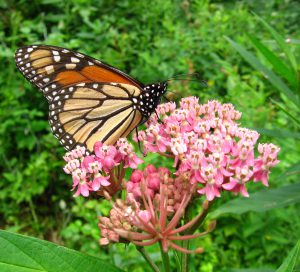Earth Day Celebrated Worldwide Wednesday, April 22nd
Wednesday, April 22nd:
Earth Day’s 45th anniversary will be celebrated worldwide. Take part in local and on-line events. We will provide additional information on-line and to the LiveGreen listserv. Not on the listserv? Email livegreen@unmc.edu and we’ll add you!
Monarch Migration Stations
By Melanie Stewart
Today is the 45th anniversary of Earth Day. The original Earth Day was a “national teach-in on the environment” as a response to an oil spill in California, industry pollution, and h
eavy use of leaded gas. Through the years numerous environmental causes have been brought to the forefront and different people have embraced different causes in different ways. Finding something you are passionate about supporting is important, whether it’s rainforest protection, energy conservation, or even the plight of the pangolin.
 One topic that’s made headlines lately is the Monarch Butterfly. It’s one of the most iconic butterflies and is known for its impressive migration. Millions of butterflies migrate thousands of miles across North America into Mexico, where they stay in the same trees every year. What makes this even more impressive is that one complete migration cycle takes multiple generations of Monarchs; each generation completing only part of the journey. Two major migration routes pass through Nebraska.
One topic that’s made headlines lately is the Monarch Butterfly. It’s one of the most iconic butterflies and is known for its impressive migration. Millions of butterflies migrate thousands of miles across North America into Mexico, where they stay in the same trees every year. What makes this even more impressive is that one complete migration cycle takes multiple generations of Monarchs; each generation completing only part of the journey. Two major migration routes pass through Nebraska.
What many people don’t know is that their population has declined to less than 10% of their original numbers, making them vulnerable to extinction.
This is largely due to habitat loss; ground used for farming instead of native plants and pesticides used in ditches next to roads. Interestingly, Monarchs are dependent on milkweed (Asclepias spp.). Not only do adults feed on the nectar and need to lay eggs on milkweed, but caterpillars only eat milkweed plants. Milkweed also provides a chemical maintained by the caterpillar/adult that serves as a defense against predators.
So what can you do? Plant some milkweed! Most people are familiar with the Common Milkweed with broad leaves and pinkish flower, but other species are native to Nebraska and zone hardy (so they come back next year) including Swamp Milkweed (shown above), Ice Ballet (white flower), and Butterfly Weed (orange flower).
Check out Iowa State’s Monarch Conservation Consortium, they are currently testing milkweed types to see if Monarchs have a favorite.
Visit MonarchJointVenture for information on habitat, gardens, land use, and to find different types of milkweed plants and seeds for purchase. The Xerces Society has information on native pollinator plants for this region, which help butterflies and other pollinators like bees. You can even create your own certified Monarch Waystation.
Watch more here or check out this month’s Nebraskaland magazine for more. Planting flowers for butterflies and other pollinators? Let us know by emailing livegreen@unmc.edu



